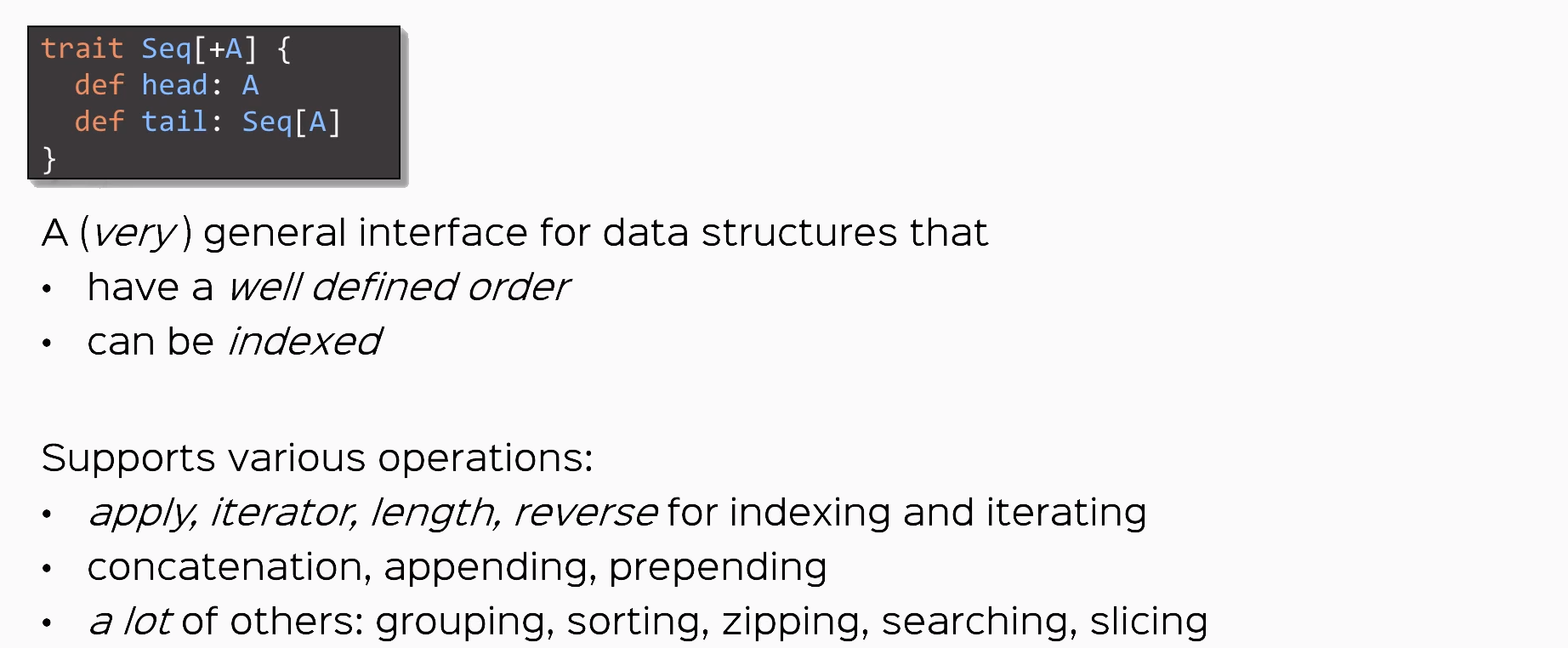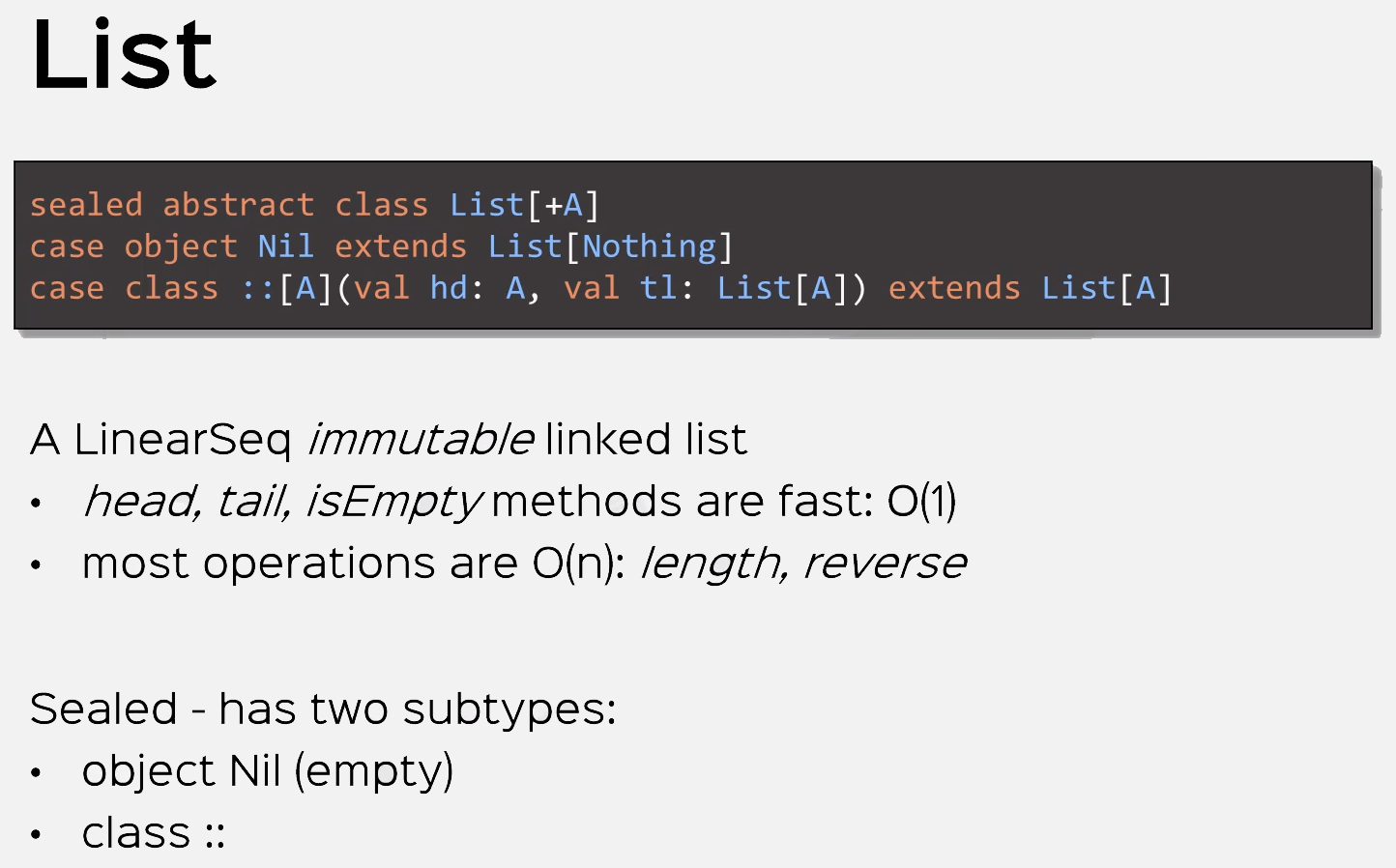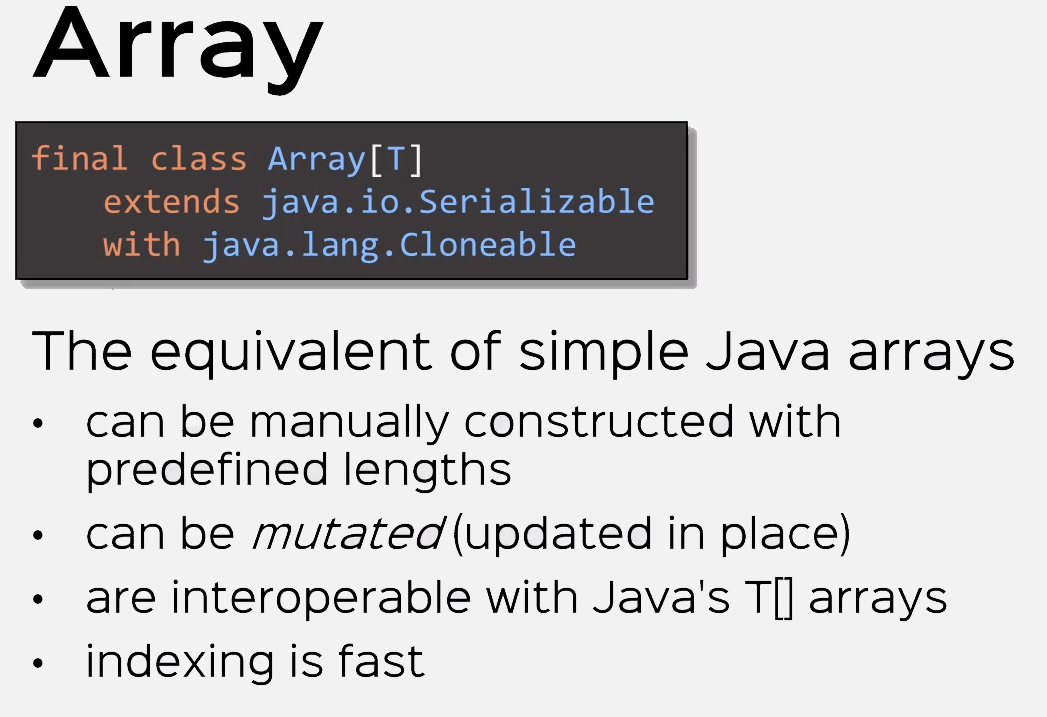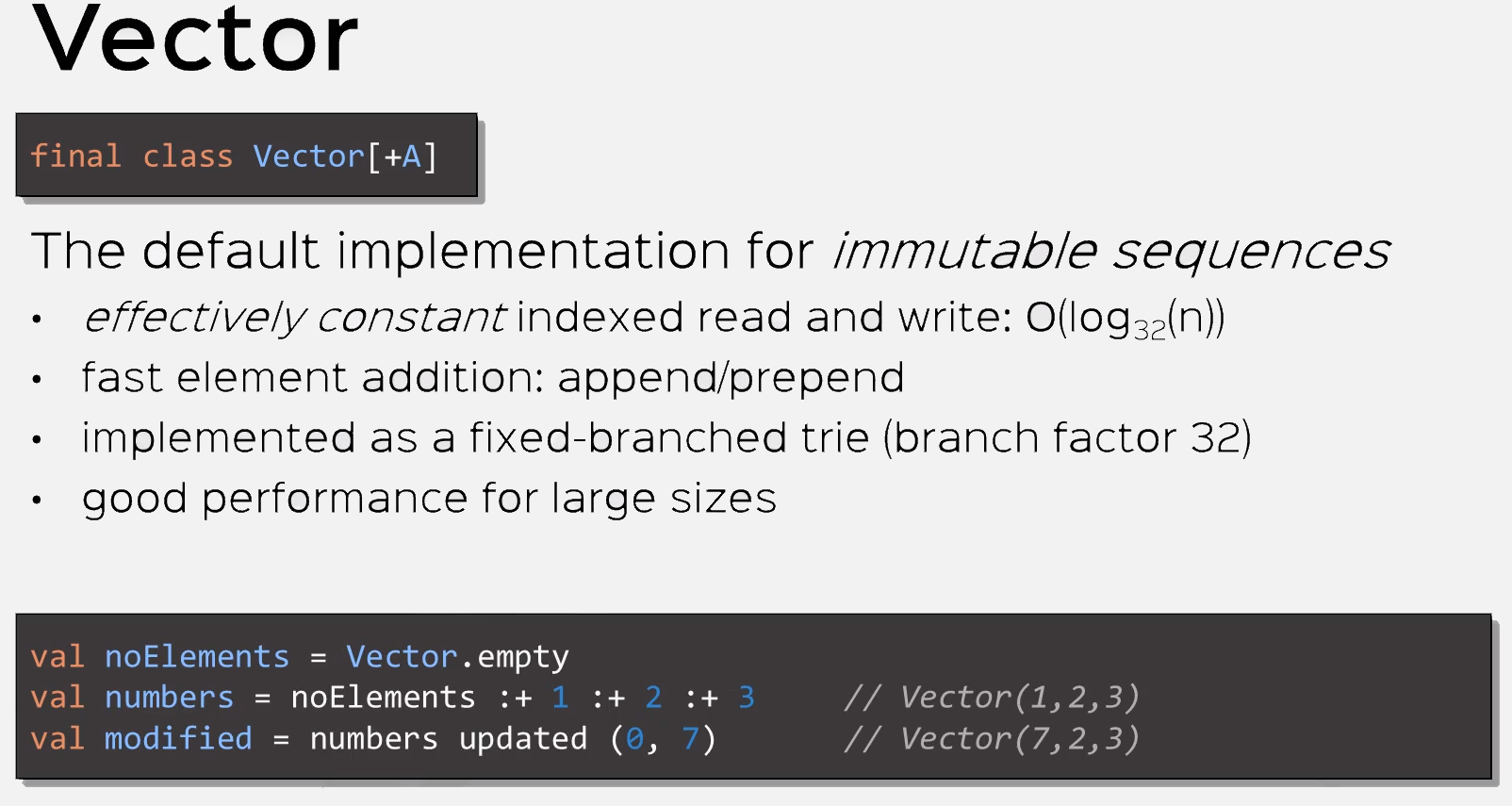ScalaSchool
The Sequence Traits: Seq, IndexedSeq, and LinearSeq
The Seq trait represents sequences. A sequence is a kind of iterable that has a length and whose
elements have fixed index positions, starting from 0.
Summary of Operations on sequences.
Indexing and Length Operations:
apply, isDefinedAt, length, indices, and lengthCompare for a Seq, the apply operation means indexing;
hence a sequence of type Seq[T] is a partial function that takes an Int argument (an index) and yields a sequence
element of type T.
In other words Seq[T] extends PartialFunction[Int, T]. The elements of a sequence are indexed from zero up to the
length of the sequence minus one. The length method on sequences is an alias of the size method of general
collections. The lengthCompare method allows you to compare the lengths of two sequences even if one of the sequences
has infinite length.
Index Search Operations:
indexOf, lastIndexOf, indexOfSlice, lastIndexOfSlice, indexWhere, lastIndexWhere, segmentLength, and
prefixLength, which return the index of an element equal to a given value or matching some predicate.
Addition operations:
+:, :+, and padTo, which return new sequences obtained by adding elements at the front or the end of a sequence.
Update operations:
updated and patch, which return a new sequence obtained by replacing some elements of the original sequence.
Sorting operations:
sorted, sortWith, and sortBy, which sort sequence elements according to various criteria.
Reversal operations:
reverse, reverseIterator, and reverseMap, which yield or process sequence elements in reverse order, from last to
first.
Comparison operations:
startsWith, endsWith, contains, corresponds, and containsSlice, which relate two sequences or search an
element in a sequence.
Multiset operations:
intersect, diff, union, and distinct, which perform set-like operations on the elements of two sequences or remove
duplicates.
A Note on update and updated:
If a sequence is mutable, it offers in addition a side-effecting update method, which lets sequence elements be
updated. Recall that syntax like seq(idx) = elem is just a shorthand for seq.update(idx, elem). Note the difference
between update and updated. The update method changes a sequence element in place, and is only available for
mutable sequences. The updated method is available for all sequences and always returns a new sequence instead of
modifying the original.

Examples
// Indexing and length:
xs(i) // (or, written out, xs apply i) The element of xs at index i.
xs isDefinedAt i // Tests whether i is contained in xs.indices.
xs.length //The length of the sequence (same as size).
xs.lengthCompare ys //Returns -1 if xs is shorter than ys, +1 if it is longer, and 0 is they have the same length.
// Works even if one of the sequences is infinite.
xs.indices //The index range of xs, extending from 0 to xs.length - 1.
// Index search:
xs indexOf x //The index of the first element in xs equal to x (several variants exist).
xs lastIndexOf x //The index of the last element in xs equal to x (several variants exist).
xs indexOfSlice ys //The first index of xs such that successive elements starting from that index form the sequence ys.
xs lastIndexOfSlice ys //The last index of xs such that successive elements starting from that index form the sequence ys.
xs indexWhere p //The index of the first element in xs that satisfies p (several variants exist).
xs segmentLength (p, i) //The length of the longest uninterrupted segment of elements in xs, starting with xs(i),
// that all satisfy the predicate p.
xs prefixLength p //The length of the longest prefix of elements in xs that all satisfy the predicate p.
// Additions:
x +: xs //A new sequence consisting of x prepended to xs.
xs :+ x //A new sequence that consists of x append to xs.
xs padTo (len, x) //The sequence resulting from appending the value x to xs until length len is reached.
// Updates:
xs patch (i, ys, r) //The sequence resulting from replacing r elements of xs starting with i by the patch ys.
xs updated (i, x) //A copy of xs with the element at index i replaced by x.
xs(i) = x //Or, written out, xs.update(i, x), only available for mutable Seqs. Changes the element of xs at index i to y.
// Sorting:
xs.sorted // A new sequence obtained by sorting the elements of xs using the standard ordering of the element type of xs.
xs sortWith lessThan //A new sequence obtained by sorting the elements of xs, using lessThan as comparison operation.
xs sortBy f //A new sequence obtained by sorting the elements of xs. Comparison between two elements proceeds by mapping
// the function f over both and comparing the results.
// Reversals:
xs.reverse //A sequence with the elements of xs in reverse order.
xs.reverseIterator //An iterator yielding all the elements of xs in reverse order.
xs reverseMap f //A sequence obtained by mapping f over the elements of xs in reverse order.
// Comparisons:
xs startsWith ys //Tests whether xs starts with sequence ys (several variants exist).
xs endsWith ys //Tests whether xs ends with sequence ys (several variants exist).
xs contains x //Tests whether xs has an element equal to x.
xs containsSlice ys //Tests whether xs has a contiguous subsequence equal to ys.
(xs corresponds ys)(p) //Tests whether corresponding elements of xs and ys satisfy the binary predicate p.
// Multiset operations:
xs intersect ys //The multi-set intersection of sequences xs and ys that preserves the order of elements in xs.
xs diff ys //The multi-set difference of sequences xs and ys that preserves the order of elements in xs.
xs union ys //Multiset union; same as xs ++ ys
xs.distinct //A subsequence of xs that contains no duplicated element.
Subtypes
Each (immutable & mutable) Seq trait has two subtraits, LinearSeq and IndexedSeq. These do not add any new
operations, but each offers different performance characteristics. A linear sequence has efficient head and tail
operations, whereas an indexed sequence has efficient apply, length, and (if
mutable) update operations.
List is a frequently used linear sequence, as is Stream. Two frequently used indexed sequences are Array and
ArrayBuffer. The Vector class provides an interesting compromise between indexed and linear access. It has both
effectively constant time indexing overhead and constant time linear access overhead. Because of this, vectors are a
good foundation for mixed access patterns where both indexed and linear accesses are used.


